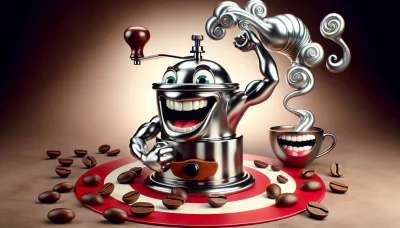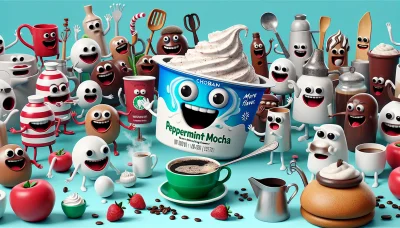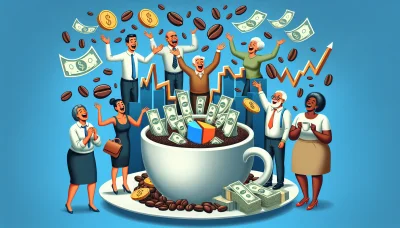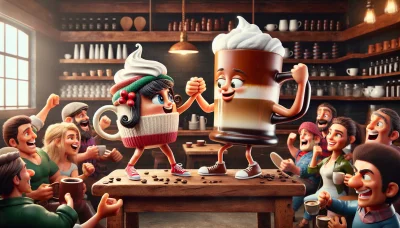Brewing Lessons Learning Never Stops Quiz
Test Your Knowledge
Question of
Brewing Lessons: Learning Never Stops
In the ever-evolving world of tea and coffee, the journey of learning is perpetual. Whether you are a seasoned barista, a home brewing enthusiast, or someone just starting to explore the intricate flavors of tea and coffee, the importance of continuous learning cannot be overstated. Each leaf and bean carries its own story, its unique blend of flavors and aromas, waiting to be unlocked and understood. The art of brewing is not just about following recipes but about understanding the subtle nuances that affect the end cup. From mastering the perfect water temperature and brewing time to exploring the vast array of brewing methods and equipment, there's always something new to learn. Moreover, with the constant introduction of new varieties of teas and coffee beans from around the world, the learning never stops. Embracing continuous learning in tea and coffee brewing not only enhances your skills but also enriches your sensory experience, allowing you to appreciate the complexity and beauty of these beloved beverages even more.
The Basics of Brewing
Brewing the perfect cup of tea or coffee is an art that has been refined over centuries, yet the basic steps remain simple and accessible to anyone. To start brewing tea, begin with fresh, cold water and bring it to a boil. The temperature of the water should be adjusted based on the type of tea; for example, green tea requires cooler water than black tea to avoid bitterness. Once the water is ready, pour it over the tea leaves, either loose in a strainer or in a tea bag, and let it steep for the recommended time, which varies by tea type. Avoid over-steeping to prevent a bitter taste.
For coffee brewing, the quality of water and the grind size of the coffee beans are crucial. Start with cold, filtered water and heat it to just below boiling. The grind size should match your brewing method: fine for espresso, medium for drip coffee, and coarse for French press. Measure your coffee grounds according to the amount of water used, typically about one to two tablespoons of coffee per six ounces of water. Combine the water and coffee grounds in your chosen device, be it a drip brewer, French press, or espresso machine, and allow it to brew until the desired strength is reached. Experimenting with the brewing time and ratios will help you find your perfect cup.
Advanced Brewing Techniques
In the world of tea and coffee, advanced brewing techniques have evolved to enhance flavor, aroma, and overall drinking experience. For coffee, methods such as the Aeropress, Cold Brew, and Siphon brewing have gained popularity. The Aeropress offers a quick and efficient way to brew a single cup with a smooth, rich taste, while Cold Brew, steeped for hours or even days, offers a milder, less acidic coffee. Siphon brewing, a more theatrical method, uses vacuum and vapor pressure to brew coffee, resulting in a clean and flavorful cup. In tea brewing, techniques like Gongfu Cha, which involves multiple short infusions to extract the full flavor of tea leaves, and cold brewing, where tea leaves are steeped in cold water for an extended period, are celebrated for their ability to highlight the nuanced flavors of high-quality teas. These advanced techniques, along with the use of specialized equipment, such as precision kettles and grinders, allow enthusiasts to explore the depth and breadth of flavors available in tea and coffee.
Common Brewing Mistakes to Avoid
- Not using the correct water temperature for the type of tea or coffee being brewed.
- Ignoring the recommended steeping times, leading to over or under-extracted flavors.
- Using tap water that hasn't been filtered, which can affect the taste of the brew.
- Not cleaning coffee makers or tea pots regularly, which can cause buildup and affect taste.
- Using pre-ground coffee or tea leaves that are not fresh, resulting in a stale taste.
- Overpacking the tea infuser or coffee filter, restricting the flow and extraction process.
- Not measuring the coffee or tea leaves properly, leading to inconsistent brews.
- Using the wrong grind size for the brewing method, which can dramatically alter the taste.
- Ignoring the quality and source of the coffee beans or tea leaves, which directly impacts flavor.
- Not pre-wetting paper filters for coffee, which can leave a papery taste in the brew.
Choosing the Right Equipment for Brewing
When it comes to brewing the perfect cup of tea or coffee, selecting the right equipment is crucial. For tea enthusiasts, a high-quality teapot or infuser can make all the difference, allowing the leaves to expand fully and release their full flavor. Glass or ceramic pots are preferred for their inert qualities, ensuring a pure taste. For coffee aficionados, a reliable coffee maker is essential. Whether you favor drip, French press, or espresso, choosing a machine with precise temperature control and consistent brewing pressure will ensure a rich and robust cup every time. Additionally, investing in a good grinder will allow you to enjoy the freshest flavors by grinding your coffee beans or tea leaves just before brewing. Remember, the key to a delightful brewing experience lies in the harmony between quality ingredients and the right equipment.
Understanding Different Types of Tea and Coffee
| Type | Name | Origin | Flavor Profile | Brewing Temperature |
|---|---|---|---|---|
| Tea | Green Tea | China, Japan | Grassy, fresh | 150-180°F (65-82°C) |
| Tea | Black Tea | India, Sri Lanka | Robust, astringent | 200-212°F (93-100°C) |
| Coffee | Arabica | Ethiopia, Brazil | Sweet, fruity | 195-205°F (90-96°C) |
| Coffee | Robusta | Vietnam, Indonesia | Strong, bitter | 195-205°F (90-96°C) |
| Tea | Oolong Tea | China, Taiwan | Floral, smooth | 180-190°F (82-88°C) |
| Tea | White Tea | China | Delicate, sweet | 160-185°F (71-85°C) |
| Coffee | Espresso | Italy | Rich, caramel | 190-196°F (88-91°C) |
Health Benefits of Tea and Coffee
Regular consumption of brewed tea and coffee has been associated with numerous health benefits, thanks to their high levels of antioxidants and other beneficial compounds. For instance, tea, especially green tea, is rich in catechins, which have been linked to improved heart health, weight loss, and a lower risk of cancer. On the other hand, coffee is a significant source of antioxidants like chlorogenic acid, which can help reduce inflammation, protect against type 2 diabetes, and support brain health. Both beverages can also enhance mental alertness and mood due to their caffeine content. Additionally, the ritual of brewing tea or coffee can have its own therapeutic benefits, offering a moment of pause and relaxation in our busy lives. For those interested in exploring these benefits further, investing in quality tea leaves or coffee beans, as well as proper brewing equipment, can enhance the experience and potency of these healthful drinks.
Brewing as a Lifelong Learning Journey
The path to mastering the art of tea and coffee brewing is a continuous learning journey, rich with endless nuances and secrets to uncover. From exploring the vast variety of beans and leaves, understanding the importance of water temperature and brewing times, to experimenting with different brewing methods and equipment, each step offers a new layer of complexity and satisfaction. Whether it's the pursuit of the perfect espresso shot, the delicate balance of flavors in a traditional tea ceremony, or the exploration of innovative brewing gadgets, the world of tea and coffee brewing invites enthusiasts to deepen their knowledge and skills, making every cup a testament to their dedication and passion for the craft.












